
Bangor is a city in and the county seat of Penobscot County, Maine, United States. The city proper has a population of 31,753, making it the state's third-largest settlement, behind Portland (68,408) and Lewiston (37,121). Bangor is known as the “Queen City.”

Fort Kent is a town in Aroostook County, Maine, United States, situated at the confluence of the Fish River and the Saint John River, on the border with New Brunswick, Canada. The population was 4,067 in the 2020 census. Fort Kent is home to an Olympic biathlete training center, an annual CAN-AM dogsled race, and the Fort Kent Blockhouse, built in reaction to the Aroostook War and in modern times designated a national historic site. Principal industries include agriculture and textiles. Fort Kent is the northern terminus of U.S. 1 and the ending point of the Northern Forest Canoe Trail.
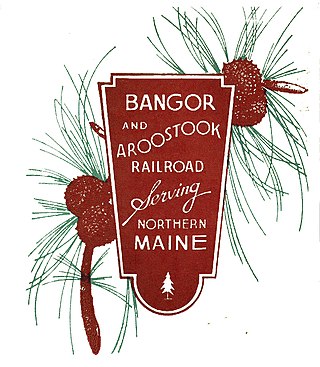
The Bangor and Aroostook Railroad was a United States railroad company that brought rail service to Aroostook County in northern Maine. Brightly-painted BAR boxcars attracted national attention in the 1950s. First-generation diesel locomotives operated on BAR until they were museum pieces. The economic downturn of the 1980s, coupled with the departure of heavy industry from northern Maine, forced the railroad to seek a buyer and end operations in 2003. It was succeeded by the Montreal, Maine and Atlantic Railway.

Seashore Trolley Museum, located in Kennebunkport, Maine, United States, is the world's first and largest museum of mass transit vehicles. While the main focus of the collection is trolley cars (trams), it also includes rapid transit trains, Interurban cars, trolley buses, and motor buses. The Seashore Trolley Museum is owned and operated by the New England Electric Railway Historical Society (NEERHS). Of the museum's collection of more than 350 vehicles, ten trolley, and railroad cars that historically operated in Maine were listed on the National Register of Historic Places in 1980, as Maine Trolley Cars.

The Katahdin Iron Works is a Maine state historic site located in the unorganized township of the same name. It is the site of an ironworks which operated from 1845 to 1890. In addition to the kilns of the ironworks, the community was served by a railroad and had a 100-room hotel. The site was listed on the National Register of Historic Places in 1969.

Fort Kent, located at the confluence of the Fish and Saint John rivers in the town of Fort Kent, Maine, United States, is the only surviving American fortification built during the border tensions with neighboring New Brunswick known as the Aroostook War. It is preserved as the Fort Kent State Historic Site, which features an original log blockhouse that is open for visits in the summer. The fort was added to the National Register of Historic Places in 1969 and declared a National Historic Landmark in 1973.
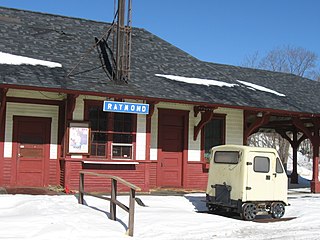
The Raymond Railroad Depot is a historic former Boston and Maine railroad station at 1 Depot Street in the center of Raymond, New Hampshire. Built in 1893, it is one of the state's finest and least-altered 19th-century stations. It is presently operated by the Raymond Historical Society as a museum, and was added to the National Register of Historic Places in 1979.

State Route 161 (SR 161) is part of Maine's system of numbered state highways. It runs 86 miles (138 km) from Fort Fairfield to Allagash. It begins at the Fort Fairfield - Andover Border Crossing along the Canada–US border to Dickey Road near the confluence of the Allagash and Saint John rivers.

The Potter Place Railroad Station is a historic railroad station on Depot Street in Andover, New Hampshire. Built in 1874, it is one of the best-preserved surviving 19th-century railroad stations in Merrimack County. It now houses the museum of the Andover Historical Society. It was listed on the National Register of Historic Places in 1989.
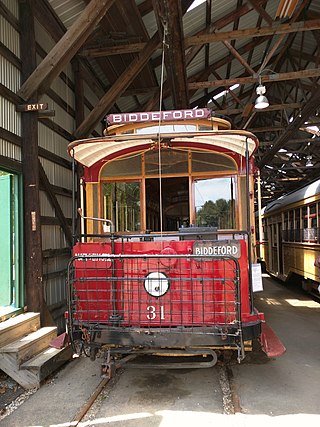
The Maine Trolley Cars are a group of 10 rail vehicles, mostly trolley cars, located in Kennebunkport, Maine. The cars were built in various years between 1893 and 1926, and the group was added to the National Register of Historic Places on November 14, 1980. The trolley cars are a small part of the large collection of vehicles at the Seashore Trolley Museum. While the museum's collection of more than 250 vehicles includes ones from several different U.S. states and a few foreign countries, the 10 vehicles in the National Register listing were all operated in the state of Maine at one time.
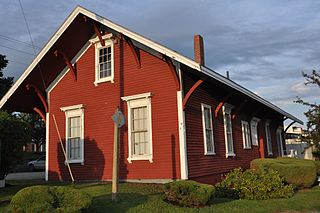
The Bucksport Railroad Station is a historic railroad station on Main Street in Bucksport, Maine. The station was built in 1874 by the European and North American Railway, and is one of a small number of surviving rural railroad stations in Maine. It is now home to the Bucksport Historical Society Museum. It was listed on the National Register of Historic Places in 1975.
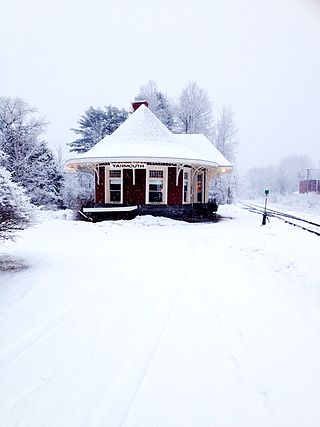
Yarmouth station of Yarmouth, Maine, is located on the east side of the railroad tracks, just south of Maine State Route 115, the town's Main Street. The railroad station was built in 1906 by the Grand Trunk Railroad, and is a well-preserved example of an early 20th-century passenger rail depot, an increasingly rare sight in the state. The building, which is now in commercial use, was added to the National Register of Historic Places on July 10, 1979.

The Portland Railroad Company Substation, now the Scarborough Historical Museum, is a former power substation of the Portland Railroad Company, a trolley service provider, at 649 United States Route 1 in Scarborough, Maine. The station was built in 1911, and is one of the few trolley-related facilities surviving in the state. The building was listed on the National Register of Historic Places on March 22, 1991.
The Frenchville Railroad Station and Water Tank are a historic railroad museum property in Frenchville, Maine. The station and water tank were built in 1910 by the Bangor & Aroostook Railroad (B&A) and were added to the National Register of Historic Places on June 20, 1995. The station was retired in 1971. The water tower became obsolete in 1958 when the diesel locomotive replaced the steam locomotive. The Town of Frenchville purchased the water tank from Bangor & Aroostook Railroad and used it as a water reservoir for the fire department until 1981. The Frenchville Historical Society took over maintenance of the site in 1985.

Oakfield Station is a historic former passenger rail station on Station Street in Oakfield, Maine. The station was built in 1911 by the Bangor and Aroostook Railroad, and is a major reminder of Oakfield's onetime importance as a railroad center. The station is home to the Oakfield Railroad Museum which is operated by the Oakfield Historical Society. It was listed on the National Register of Historic Places on June 25, 1987.

The Philo Reed House is an historic house at 38 Main Street in Fort Fairfield, Maine. Built in 1907 to a design by Coombs and Gibbs, it is one of the town's grandest houses, a transitional combination of Queen Anne and Colonial Revival styling. It was built for Philo Reed founder of one of the nation's largest seed potato companies of the time. It was listed on the National Register of Historic Places in April 1986.
The Benjamin C. Wilder House is an historic house at 1267 Main Street in Washburn, Maine, United States. Built about 1852, it is a well-preserved example of mid-19th century vernacular architecture in northern Aroostook County, built in the first decade after widespread settlement began of the area. The house was listed on the National Register of Historic Places in 1987. It is now owned by the local Salmon Brook Historical Society and operated as a historic house museum.
The Jean-Baptiste Daigle House is a historic house at 4 Dubé Street in Fort Kent, Maine. Built c. 1840, it is a rare surviving example of an Acadian log house, and the only one known to be near its original location. It was built by one of a father-son pair, each named Jean-Baptiste Daigle, and moved a short distance about 20 years after its construction. It is now covered by weatherboard siding, obscuring its log structure. The house was listed on the National Register of Historic Places in 2013.

The Market Square Historic District of Houlton, Maine encompasses that town's historic late-19th century central business district. Centered on the junction of Market Square, Court Street, Water Street, and Main Street, it includes a relatively cohesive assortment of brick and masonry commercial buildings, designed by architects and built between 1885 and 1910, following the arrival of the Bangor and Aroostook Railroad. The district was listed on the National Register of Historic Places in 1980.
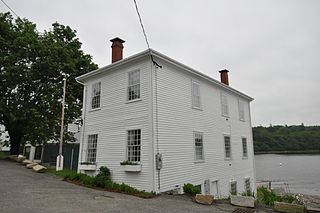
The Gates House is a historic house museum at 344 Port Road in Machiasport, Maine. Built in 1807, it is a remarkably high-quality Federal period house built in what was then a frontier area. The house is now owned by the Machiasport Historical Society, which uses it as its headquarters and museum. It was listed on the National Register of Historic Places in 1975.



















